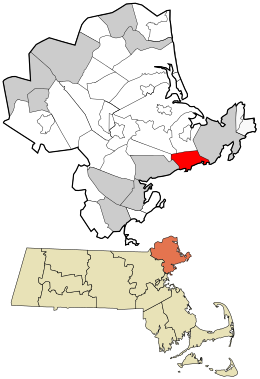Manchester-by-the-Sea
| Manchester-by-the-Sea, Massachusetts | ||
|---|---|---|
| Town | ||

The First Parish Church in central Manchester-by-the-Sea
|
||
|
||
 Location in Essex County and the state of Massachusetts. |
||
| Coordinates: 42°34′40″N 70°46′10″W / 42.57778°N 70.76944°WCoordinates: 42°34′40″N 70°46′10″W / 42.57778°N 70.76944°W | ||
| Country | United States | |
| State | Massachusetts | |
| County | Essex | |
| Settled | 1629 | |
| Incorporated | 1645 | |
| Government | ||
| • Type | Open town meeting | |
| Area | ||
| • Total | 18.3 sq mi (47.3 km2) | |
| • Land | 9.2 sq mi (23.9 km2) | |
| • Water | 9.0 sq mi (23.4 km2) | |
| Elevation | 30 ft (9 m) | |
| Population (2010) | ||
| • Total | 5,136 | |
| • Density | 280/sq mi (110/km2) | |
| Time zone | Eastern (UTC-5) | |
| • Summer (DST) | Eastern (UTC-4) | |
| ZIP code | 01944 | |
| Area code(s) | 351 / 978 | |
| FIPS code | 25-37995 | |
| GNIS feature ID | 0619451 | |
| Website | www |
|
Manchester-by-the-Sea (or simply Manchester) is a town on Cape Ann, in Essex County, Massachusetts, in the United States. The town is known for scenic beaches and vista points. At the 2010 census, the town population was 5,136.
Manchester was first settled by Europeans in 1629 and was officially incorporated in 1645. It was formed out of territory taken from Salem (that portion since given to Beverly) and Gloucester.
The community thrived primarily as a fishing community for over 200 years. Its economy shifted to that of a Boston area summer colony starting in 1845, when Richard Dana, a Boston-based poet, built a house in the town. Over the next fifty years, development of summer houses along the coastline established the community as Boston society's community of choice for summer residency. The trend continued with designs by other notable architects, such as "Sunny Waters", designed by John Hubbard Sturgis for his older brother, Russell, in 1862.
The most famous of these "summer cottages" was Kragsyde, built on Smith's Point in 1883 and demolished in 1929. Commissioned by George Nixon Black, the Peabody and Stearns-designed residence has been hailed as the zenith of the Shingle style substyle of the Queen Anne style of architecture.
To prevent confusion with the nearby and much larger city of Manchester, New Hampshire, the name of the town was officially changed in 1989 following a close town meeting vote that year and an act of the state legislature passed on September 25, 1989.
The name change was driven by Edward Corley, a longtime resident of Manchester. All town documents, and the town seal, now use the name "Manchester-by-the-Sea", and as a result of some minor resident activism, so do the majority of public and private lists of Massachusetts cities and towns, including that of the state government.
...
Wikipedia

